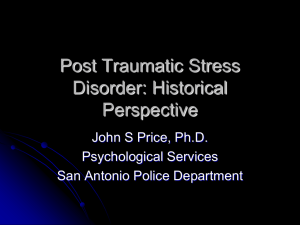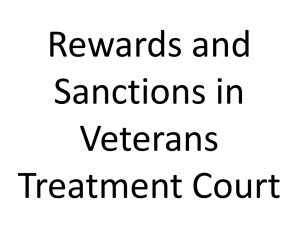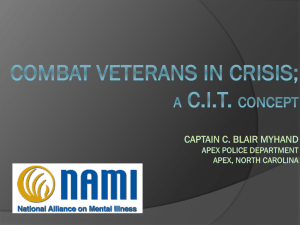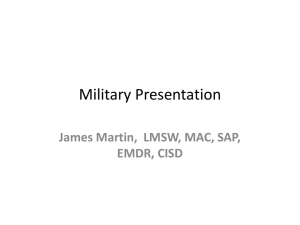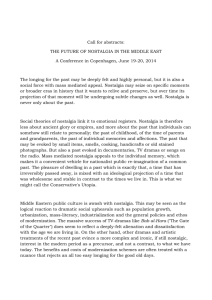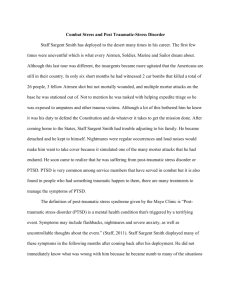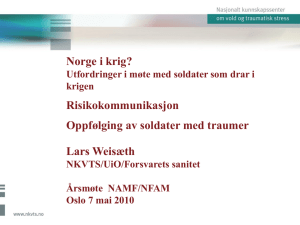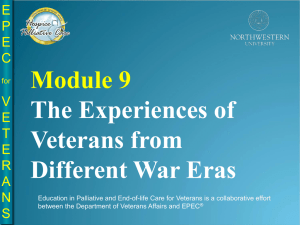Birdy-PTSD History Powerpoint
advertisement
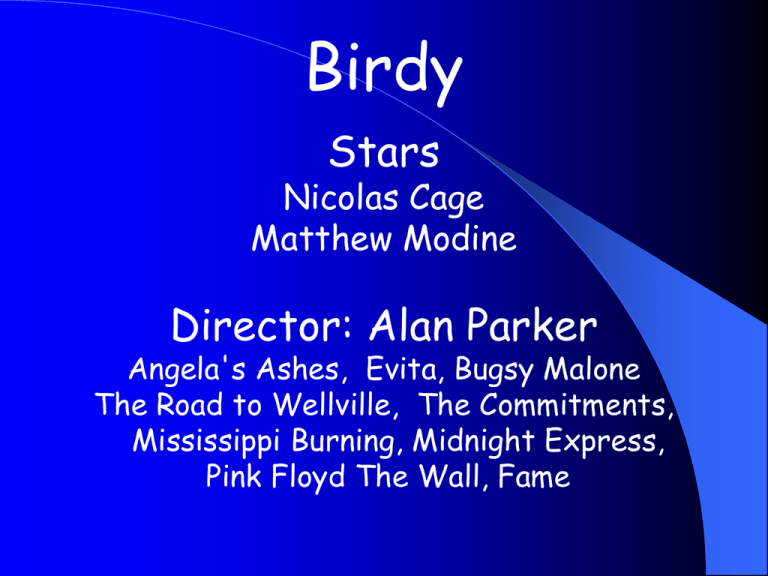
Birdy Stars Nicolas Cage Matthew Modine Director: Alan Parker Angela's Ashes, Evita, Bugsy Malone The Road to Wellville, The Commitments, Mississippi Burning, Midnight Express, Pink Floyd The Wall, Fame Birdy Based on 1978 Novel By William Wharton Born Albert William du Aime UCLA: B.A. Art;Psychology Ph.D. Died 10/29/2008 Novel about World War II Veterans Movies from other novels: “Dad” and “A Midnight Clear” Agenda Have fun Watching movie Learning Joining conversation After the movie.. PTSD Clinical issues, day-to-day veterans’ issues, cinematic considerations Matt Miller, LCSW;Veterans Administration --Clinical considerations Tom Price, LCSW,Veteran, St. Patrick Center --Realities for returned veterans History of PTSD DSM posttraumatic stress disorder ICD post-traumatic stress disorder Elsewhere, post traumatic stress disorder PTSD Term created in the mid-1970s, Officially added as Anxiety Disorder DSM-III (1980) DSM-5 (2013) created new category: Trauma and Stressor-Related Disorders PTSD-like descriptions Ancient Egypt Greece Rome India Elizabethan England Herodotus In battle of Marathon in 490 B.C. Athenian warrior went permanently blind although “wounded in no part of his body.” When he saw nearby comrade killed Oddysey 3-week trip home from the Trojan War becomes a ten-year journey To avoid dangers of Scylla and Charybdis, do not resist the dangers (much as modern trauma sufferers must overcome their resistance to memories of the traumatic stressors). Oddysey Sorceress Circe admonishes him, "Do the works of war concern you still, and toil? He is tempted by Sirens and the addictive lotus fruit First Medical Terminology Swiss Military Physicians-1678 melancholy incessant thinking of home disturbed sleep or insomnia weakness loss of appetite anxiety cardiac palpitations stupor Fever First Medical Terminology “Nostalgia” Nostalgia 1863 Public outcry about numerous “insane soldiers” wandering around First military hospital for the insane Most common diagnosis: Nostalgia. French Doctors: maladie du pays, (Disease of the Country) German doctors: heimweh (Homesick) American Civil War military physicians diagnosed paralysis tremors self-inflicted wounds nostalgia American Civil War Jacob Mendes Da Costa-1871 Study Identified “Soldier’s Heart” (DaCosta’s Syndrome)severe palpitations; an ailment of the sympathetic nervous system Soldiers on normal leave often collapsed with emotional illness at home, even when asymptomatic on duty 1901 Schreckneurosen Bruns and Stierlin studied the symptoms of survivors of volcanic eruptions and mining accidents they coined the term "Schreckneurosen"- the terror neuroses. Russian Army of 1905 First army to determine that mental collapse was a direct consequence of the stress of war and to regard it as a legitimate medical condition German physician Honigman served with Red Cross there, and coined the term “war neurosis” [Kriegsneurose] World War I High psychiatric casualties attributed to the new large-caliber artillery. Believed the impact of the shells produced a concussion Thus the term “shell shock” Freud:“war neurosis”caused by conflict between a soldier’s “war ego” and his “peace ego.” World War II 1945, Grinker and Spiegel : “Combat… or Battle Stress” “Combat Exhaustion” “Acute combat reaction" “Battle Fatigue” 1952 DSM-I “Gross Stress Reaction” …exposed to severe physical demands or extreme emotional stress, such as in combat or in civilian catastrophe (fire, earthquake, explosion, etc) [may be] “previously…normal” The particular stress involved will be specified as (1)combat or (2) civilian catastrophe DSM-II -1968 307.3 Adjustment Reaction of Adult Life [different coding for different life stages] Example: Fear associated with military combat and manifested by trembling, running, and hiding. First Medical Terminology “Nostalgia” PTSD—Back to Today Term created in the mid-1970s, Officially added as Anxiety Disorder DSM-III (1980) DSM-5 (2013) created new category: Trauma and Stressor-Related Disorders Clinical Considerations In what ways was Al prepared and unprepared for the stress of combat before he joined the Army? How should we diagnose Al, if at all? How should we diagnose Birdy? Does Birdy's behavior in the asylum correspond with dissociation, or is it more like a form of catatonia? Clinical Considerations How does Birdy’s pre-military behavior relate to his postdeployment behavior, if at all? Did the movie portray Birdy's preand post-deployment behaviors as maladaptive coping, or someone "being himself?" Clinical Considerations How does the movie portray the treatment options available to these two veterans in the Vietnam era, and how has that changed today? What's up with that ending?! What does it mean, what does the writer imply about the two men, and what's going to happen to each of them? Cinematic Considerations Chris Clark, BA, Cinema St. Louis You! Your comments. Your questions for panel members Fill out evaluations You Us



